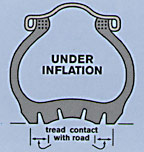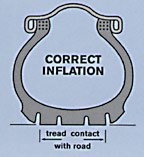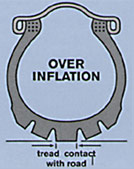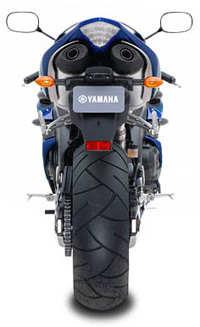Scooter and Motorcycle Tyre Information
Looking for motorbike tyres?
Use the links below to go straight to a section
Running in new tyres
Why you should run in new tyres
How to run in sor scrub in new tyres
What the letters and numbers mean
Tyre speed ratings
Tyre load ratings
Types of tyre
Combinations of tyre types
Useful information
Motorcycle and scooter tyres, the law and MOT's
Tyre pressures
Tyre clearances
Running in a New Scooter or Motorcycle Tyre
New tyres can be very slippery (especially if ridden in the wet) and need to be 'run in' correctly to help prevent any accidents.
The slippery surface on a new tyre is caused by 2 main reasons.
~When new, a tyre has a very smooth surface and in order to obtain maximum grip, the smooth surface needs to be 'scrubbed in'.
~Some manufacturers use 'releasing agents' when they make the tyres. These 'releasing agents' contain 'anti-ageing preservatives' which help to stop a tyre degrading whilst in storage. Releasing agents need to be scrubbed from a new tyres surface.
Other Reasons for Running in New Scooter or Motorcycle Tyre's
~A new tyre needs to be seated on the wheel. This is not fully achieved when fitting a tyre and it needs to be ridden on with caution to complete the process.
~In order to achieve optimum performance, the various components of the tyre (belts, tread strip etc) need to be correctly bedded in to one another. If not run in correctly, a tyre may not give the best possible performance.
How to Run or Scrub In New Scooter or Motorbike Tyre's
Although rubbing a new tyres surface with an abrasive material (like emery paper) doesn't help the running in process, it can help to remove releasing agents and assist with providing initial grip.
A new tyre should be run in for at least 100 miles (or more in wet or poor conditions)
The motorbike or scooter should be kept as upright as possible for the first 50 miles, then gradually leaned into the corners. As the mileage increases, the lean angle can be increased. Try to avoid harsh acceleration and braking and keep the power delivery as smooth as possible whilst running in tyres.
Most incidents where riders come off their motorcycles or scooters after fitting new tyres usually happen at low speeds (when the forces acting on the tyre are lower) and because of the following reasons:
~Pulling out onto the road when leaving the fitting bay or just after fitting a new tyre
~Turning right when pulling out of a T junction
~On a low speed roundabout
What the Letters and Numbers Mean (Tyre Dimensions)
The tables below are examples of some of the more commonly used tyre sizes
190/50 ZR17 M/C
| Tyre size | Description |
|---|---|
190 |
Section (width) in mm |
50 |
Aspect (height) of the tyre. Shown as a percentage of the tyre width |
Z |
Speed rating (Z=150+mph) |
R |
Radial construction tyre |
17 |
Wheel rim diameter in inches |
M/C |
Tyre constructed for motorcycle use |
150/60 R17 M/C 66H
| Tyre size | Description |
|---|---|
150 |
Section (width) in mm |
60 |
Aspect (height) of the tyre. Shown as a percentage of the tyre width |
R |
Radial construction tyre |
17 |
Wheel rim diameter in inches |
M/C |
Tyre constructed for motorcycle use |
66 |
Load index (how much weight the tyre can take) |
H |
Speed rating (H=up tp 130mph) |
150/70-17 M/C 69V
| Tyre size | Description |
|---|---|
150 |
Section (width) in mm |
70 |
Aspect (height) of the tyre. Shown as a percentage of the tyre width |
- |
Bias-ply (cross ply) construction tyre |
17 |
Wheel rim diameter in inches |
M/C |
Tyre constructed for motorcycle use |
69 |
Load index (how much weight the tyre can take) |
V |
Speed rating (V=up tp 150mph) |
3.00-19 M/C 49S
| Tyre size | Description |
|---|---|
3.00 |
Section (width) in Inches |
- |
Bias-ply (cross ply) construction tyre |
19 |
Wheel rim diameter in inches |
M/C |
Tyre constructed for motorcycle use |
49 |
Load index (how much weight the tyre can take) |
S |
Speed rating (H=up tp 112mph) |
Scooter and Motorcycle Tyre Speed Ratings
The table below is of the speed ratings for different tyres (e.g. 150/70-17 M/C 69V). It is not advisable to fit lower or higher rated tyres on a motorcycle or scooter (for example-fitting 'F' or 50mph rated tyres on a Suzuki GSXR1000!). Even if you never travel at the speeds indicated by a tyres speed rating, fitting incorrectly rated tyres will result in sever loss of performance and handling and may result in tyre failure (blow out!).
Letter |
Max MPH |
Max KPH |
B |
31 mph |
50 kph |
F |
50 mph |
80 kph |
J |
62 mph |
100 kph |
L |
74 mph |
120 kph |
M |
81 mph |
130 kph |
N |
87 mph |
140 kph |
P |
93 mph |
150 kph |
Q |
100 mph |
160 kph |
R |
106 mph |
170 kph |
S |
112 mph |
180 kph |
T |
118 mph |
190 kph |
H |
130 mph |
210 kph |
V |
up to 149 mph |
up to 240 kph |
(V) |
over 149 mph |
over 240 kph |
Z |
over 149 mph |
over 240 kph |
W |
up to 168 mph |
up to 270 kph |
(W) |
over 168 mph |
over 270 kph |
Motorbike and Scooter Load Ratings (Index)
The table below shows how many kilograms different tyre load rating numbers are suitable to take
Load Index | KG's |
|---|---|
0 |
45 kg |
1 |
46.2 kg |
2 |
47.5 kg |
3 |
48.7 kg |
4 |
50 kg |
5 |
51.5 kg |
6 |
53 kg |
7 |
54.5 kg |
8 |
56 kg |
9 |
58 kg |
10 |
60 kg |
11 |
61.5 kg |
12 |
63 kg |
13 |
65 kg |
14 |
67 kg |
15 |
69 kg |
16 |
71 kg |
17 |
73 kg |
18 |
75 kg |
19 |
77.5 kg |
20 |
80 kg |
21 |
82.5 kg |
22 |
85 kg |
23 |
87.5 kg |
24 |
90 kg |
25 |
92.5 kg |
26 |
95 kg |
27 |
97.5 kg |
28 |
100 kg |
29 |
103 kg |
30 |
106 kg |
31 |
109 kg |
32 |
112 kg |
33 |
115 kg |
34 |
118 kg |
35 |
121 kg |
36 |
125 kg |
37 |
128 kg |
38 |
132 kg |
39 |
136 kg |
40 |
140 kg |
41 |
145 kg |
42 |
150 kg |
43 |
155 kg |
44 |
160 kg |
45 |
165 kg |
46 |
170 kg |
47 |
175 kg |
48 |
180 kg |
49 |
185 kg |
50 |
190 kg |
51 |
195 kg |
52 |
200 kg |
53 |
206 kg |
54 |
212 kg |
55 |
218 kg |
56 |
224 kg |
57 |
230 kg |
58 |
236 kg |
59 |
243 kg |
60 |
250 kg |
61 |
257 kg |
62 |
265 kg |
63 |
272 kg |
64 |
280 kg |
65 |
290 kg |
66 |
300 kg |
67 |
307 kg |
68 |
315 kg |
69 |
325 kg |
70 |
335 kg |
71 |
345 kg |
72 |
355 kg |
73 |
365 kg |
74 |
375 kg |
75 |
387 kg |
76 |
400 kg |
77 |
412 kg |
78 |
425 kg |
79 |
437 kg |
80 |
450 kg |
81 |
462 kg |
82 |
475 kg |
83 |
487 kg |
84 |
500 kg |
85 |
515 kg |
86 |
530 kg |
87 |
545 kg |
88 |
560 kg |
89 |
580 kg |
90 |
600 kg |
91 |
615 kg |
92 |
630 kg |
93 |
650 kg |
94 |
670 kg |
95 |
690 kg |
96 |
710 kg |
97 |
730 kg |
98 |
750 kg |
99 |
775 kg |
Different Types of Scooter and Motorcycle Tyres
There are 3 main types of motorcycle and scooter tyre construction.
Radial tyres~These are generally wider tyres designed to fit on wider rims. Radial tyres have a more supple or flexible carcass which makes them better suited to modern motorcycles.
Bias tyres~These are generally narrower tyres designed for bikes produced in the 1980's with more rigid frames.
Crossply~Designed for classic motorbikes and scooters and generally fitted with an innertube inside the tyre.
Tyres can also be split into 2 main group's:
Tube type tyres~These tyres require an inner tube to be fitted inside the tyre. Most spoked wheel motorcycles (for example off road and MX motorcycles) use a tube type tyre because without an innertube, the air would seep out of the holes where the spokes go in.
Tubeless tyres~These tyres don't require an inner tube. Fitted commonly to most modern solid wheel bikes
Combinations of Tyre Types That Can or Can't Be Fitted
The charts below show combinations of tyre types that can and can't be used on a motorcycle. Using the wrong tyre types will mean an MOT failure.
Please remember-Just because a mixed construction fitment is legal doesn't necessarily mean that it will be suitable for the motorbike or scooter.
The mixture's of tyre types below are legal in the UK
Front tyre |
Rear tyre |
Bias-ply front |
Bias-ply rear |
Bias-belt front |
Bias-belt rear |
Radial front |
Radial rear |
Bias-ply front |
Bias-belt rear |
Bias-ply front |
Radial rear |
Bias-belt front |
Radial rear |
The mixture's of tyre types below are illegal in the UK
Front tyre |
Rear tyre |
Bias-belt front |
Bias-ply rear |
Radial front |
Bias-ply rear |
Radial front |
Bias-belt rear |
Useful Information
Tyre Pressure Conversion Chart
Bar |
PSI (pounds per square inch) |
1.2 |
17 |
1.25 |
18 |
1.3 |
19 |
1.4 |
20 |
1.5 |
22 |
1.6 |
23 |
1.7 |
24 |
1.75 |
25 |
1.8 |
26 |
1.9 |
28 |
2.0 |
29 |
2.1 |
30 |
2.2 |
31 |
2.25 |
32 |
2.3 |
33 |
2.4 |
34 |
2.5 |
36 |
2.6 |
37 |
2.7 |
39 |
2.8 |
40 |
2.9 |
42 |
3.0 |
44 |
3.1 |
45 |
3.2 |
46 |
Alpha to metric conversion table
Alpha size |
Equivalent metric size |
MH90 |
80/90 |
MJ90 |
90/90 |
MM90 |
100/90 |
MN90 |
110/90 |
MR90 |
120/90 |
MT90 |
130/90 |
MU85 |
140/80 |
MU90 |
140/90 |
MV85 |
150/80 |
MV90 |
150/90 |
For example: A tyre marked MT90-16 is the same as a 130/90-16 tyre.
A tyre marked MH90-21 would be the same as an 80/90-21 tyre.
Scooter and Motorcycle Tyres, MOT's and the Law
Below are the guidelines for checking your motorcycle or scooter tyres to ensure they are safe for road use and to ensure they meet MOT and legal requirements for the UK.
Tread depth and tyre condition
Over one quarter of MOT test failures are due to worn tyres and running your motorbike or scooter on badly worn tyres can result in heavy fines and points on your licence!
Below are a few legal and MOT requirements:
~Tyres must be suitable (i.e. of the correct specification and size) for the use to which the vehicle is being put and must be inflated to the vehicle or tyre manufacturers' recommended pressures (in other words, don't try and put car tyres on a motorbike!).
~If fitted with a direction arrow, tyres must be fitted to spin in the direction of forward wheel rotation
~Tyres will be checked for tread depth and condition as well as sidewall condition (look for age cracks starting to appear on the tyre's wall)
~Bikes and scooters up to 49cc (max speed 30mph) must have visible tread on the tyre
~Bikes and scooters over 49cc (or that can travel above 30mph) must have at least 1mm of visible tread over 75% of the tyre and the tread must be continuous (so you can't have 40% of the tyre on each side with good tread and a bald stripe in the middle!)
Most manufacturers recommend changing tyres once the tread depth is down to 2mm as once the tread gets below 2mm, acceleration, braking and handling can be severely affected.
~A cut in excess of 25mm or 10% of the section (width of the tyre) , whichever is the greater, measured in any direction on the outside of the tyre and deep enough to reach the ply or cord would deem the tyre illegal.
~The tyre must not have any lump, bulge or tear caused by separation or partial failure of its structure
Scooter and Motorcycle Tyre 'E' Marks
From 1 June 1997 all new motorbike and scooter tyres must be ECE or EU approved and display an 'E' or 'e' mark.
Since 1 January 1995 it has been illegal for any person to supply re-treaded tyres unless they are marked to indicate compliance with the current BS AU 144 standard. It is also illegal for any person to supply a part-worn tyre which does not comply with legal requirements and which does not have tread grooves at least 2mm deep.
Motorcycle, Scooter and Puncture repairs
Legal number of repairs allowed for MOT's:
Up to 'J' speed rating-a maximum of 2 repairs, not exceeding 6mm in diameter.
'L' to 'V' speed ratings-a maximum of 1 repair not exceeding 3mm in diameter
No repairs are permitted on tyres above the 'V' speed rating (as stated by the BSAU159f)
The repairs are restricted to the center of the tread area, not more than 25% of the tyres width either side of the center line and not on the tyres sidewall.
Repairs must be made using a 'mushroom' type plug.
Scooter and Motorcycle Tyre Pressures
Motorcycle and scooter tyres slowly lose air pressure through the rubber of the tyre, which is why it is important to regularly check the tyre pressures before riding.
Check tyre pressures once a week and always when the tyres are cold. Correct inflation pressures are critical to a motorcycle or scooter's safe handling.
Incorrect inflation pressures can lead to tyre damage, poor handling and irregular and rapid wear.
If tyre pressures have been adjusted for 'off road use' (e.g. track days or trial riding) they must be returned back to the recommended pressures before being used back on the road.
Check your owners manuel for the manufacturers recommended tyre pressures. On many bikes, recommended tyre pressures can also be found on the chain guard.
Tyre pressure is the first thing you should check if the bike starts handling badly. Even a couple of pounds difference in the pressure can make a huge difference and rapidly increase a tyres wear.
The effect of over or under inflation can is shown in the pictures below:


As a very rough guideline............
Most scooters run tyres around 30psi in the front and rear tyres (often around 26psi in the front and 29psi in the rear)
Most sports/touring/commuting motorbikes run 36psi in the front tyre and 42psi in the rear
But, the above pressures are very rough guidelines only, you should check your bike's handbook or ask the manufacturer or authorised dealer for the exact tyre pressures!
Motorbike and Scooter Tyre Clearance
As a tyre rotates, the movement forces and the heat generated cause the tyre to expand (this effect is greater in Bias-ply or Crossply tyres).
As a general guideline, always make sure there is at least 4mm of lateral (sideways) clearance and 14mm of radial clearance between the tyre and any part of the motorcycle or scooter, especially the mudguards, forks, swing-arm and hugger.
Be especially careful when fitting tyre sizes other than the manufacturers recommended tyre sizes.

